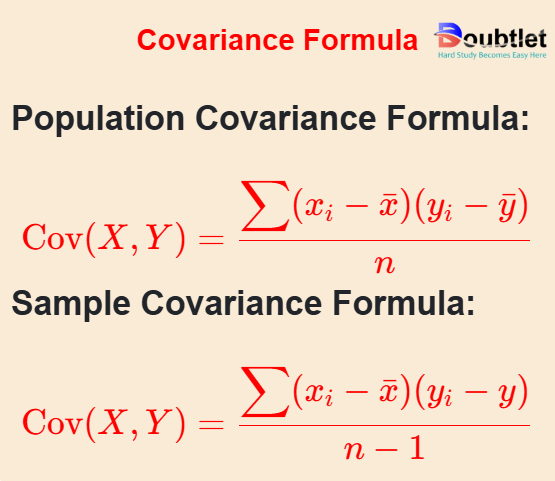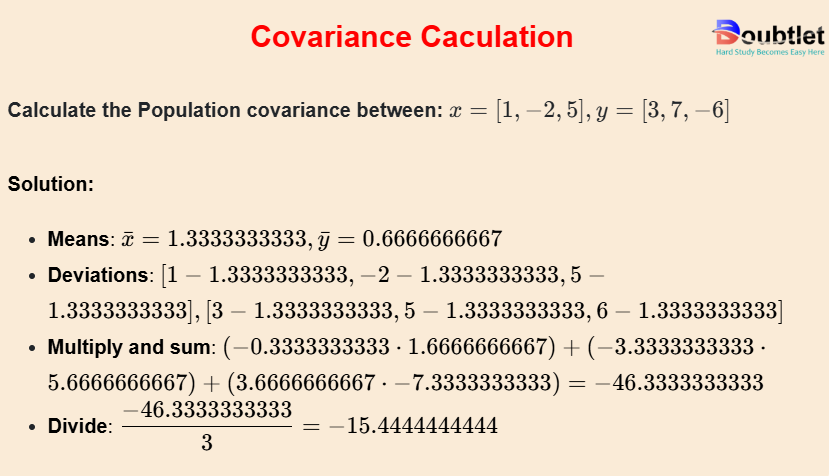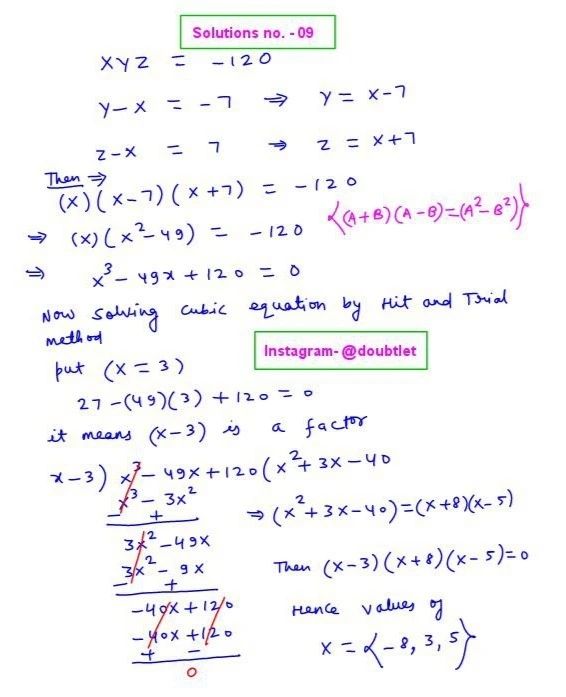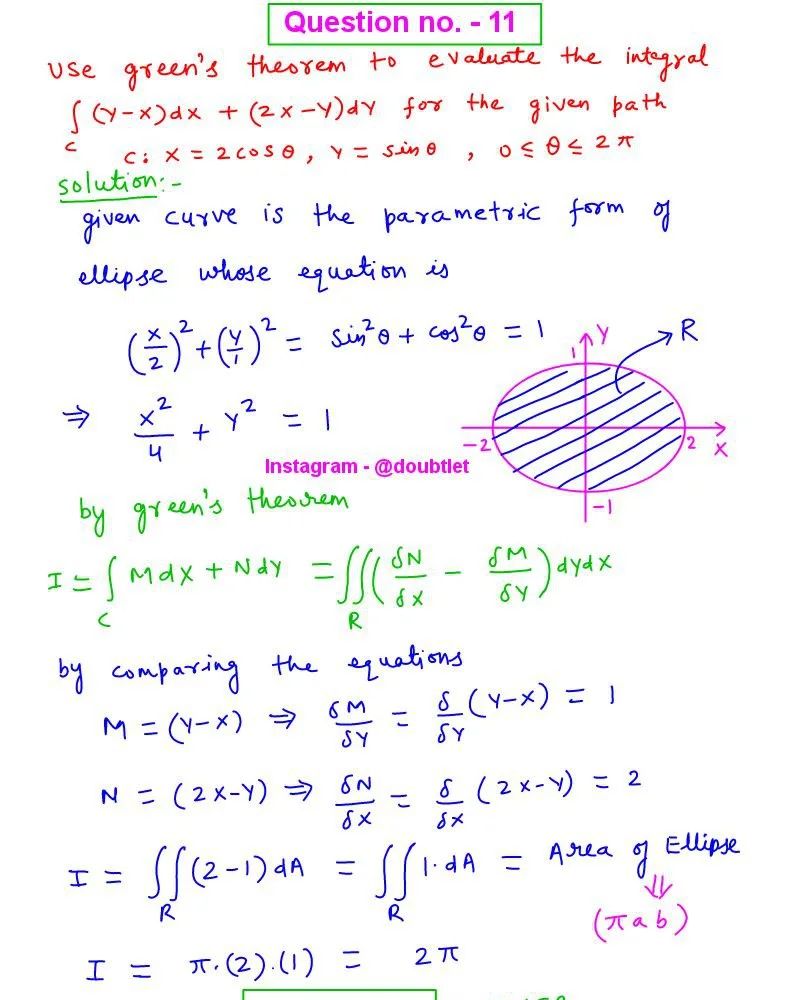









Covariance Calculator
This calculator will help you to calculate the covariance for the given set of values with steps shown.Related Calculators:Correlation Coefficient CalculatorVariance Calculator

Neetesh Kumar | January 06, 2025
Share this Page on:
![]()
![]()
![]()
![]()
![]()
- 1. Introduction to the Covariance Calculator
- 2. What is the Formulae used
- 3. How do I find the Covariance?
- 4. Why choose our Covariance Calculator?
- 5. A Video for explaining this concept
- 6. How to use this calculator?
- 7. Solved Examples on Covariance
- 8. Frequently Asked Questions (FAQs)
- 9. What are the real-life applications?
- 10. Conclusion
Understanding relationships between variables is crucial in data analysis, and covariance is a powerful metric for this purpose. The Covariance Calculator for a Table helps you compute this statistical measure quickly and accurately, whether you’re working on financial analysis, scientific research, or academic projects.
1. Introduction to the Covariance Calculator
Covariance measures the relationship between two variables, indicating whether they increase or decrease together. A positive covariance means the variables move in the same direction, while a negative value means they move inversely.
The Covariance Calculator automates these calculations for tabular data, saving time and effort while ensuring accuracy. Imagine analyzing the relationship between advertising spend and revenue. Covariance gives you a clear picture of how they are correlated, forming the basis for actionable insights.
2. What is the Formulae used?
The formula for covariance is:
Population Covariance Formula:
Sample Covariance Formula:
Where:
- : Individual data points of variables and
- : Means (averages) of and
- : Number of data points
The calculation involves:
- Finding the means of and .
- Subtracting these means from each corresponding data point.
- Multiplying the deviations, summing them, and dividing by .

3. How Do I Find Covariance?
To calculate covariance manually:
- Organize the Data: Arrange the values of and in a table.
- Calculate Means: Find the averages of and .
- Compute Deviations: Subtract the mean from each data point.
- Multiply and Sum: Multiply deviations for corresponding data points and sum them.
- Divide: Divide the sum by .
Example:
Dataset:
Steps:
- Means:
- Deviations:
- Multiply and sum:
- Divide:
The Sample covariance is:
Manually calculating covariance for larger datasets can be challenging, but our calculator does it effortlessly.

4. Why choose our Covariance Calculator?
Our calculator page provides a user-friendly interface that makes it accessible to both students and professionals. You can quickly input your square matrix and obtain the matrix of minors within a fraction of a second.
Our calculator saves you valuable time and effort. You no longer need to manually calculate each cofactor, making complex matrix operations more efficient.
Our calculator ensures accurate results by performing calculations based on established mathematical formulas and algorithms. It eliminates the possibility of human error associated with manual calculations.
Our calculator can handle all input values like integers, fractions, or any real number.
Alongside this calculator, our website offers additional calculators related to Pre-algebra, Algebra, Precalculus, Calculus, Coordinate geometry, Linear algebra, Chemistry, Physics, and various algebraic operations. These calculators can further enhance your understanding and proficiency.
5. A video based on how to Evaluate the Covariance.
6. How to use this calculator?
Follow these simple steps to calculate covariance:
- Input Data: Enter values for and in tabular format.
- Click Calculate: Let the calculator handle the heavy lifting.
- View Results: Instantly see the covariance value and related metrics.
Say goodbye to manual calculations and hello to effortless analysis.
7. Solved Examples on Covariance
Example 1:
Find the Sample Covariance for the dataset
Solution:
- Calculate means:
- Compute deviations:
- Multiply and sum:
- Divide:
The Sample covariance is:
Example 2: Tabular Data:
| x | y |
| 2 | 3 |
| 4 | 5 |
| 6 | 7 |
Solution:
- Means:
- Deviations:
- Multiply and sum:
- Divide:
The Sample covariance is:
Our calculator computes these results in seconds and displays them in a clear format.
8. Frequently Asked Questions (FAQs)
Q1. What is covariance?
Covariance measures the direction of a relationship between two variables.
Q2. Can the calculator handle large datasets?
Yes, it’s optimized for extensive tabular data.
Q3. Is the Covariance Calculator free?
Absolutely, it’s free to use.
Q4. Can I calculate covariance for negative values?
Yes, negative values are fully supported.
Q5. Does it support real-time updates?
Yes, results update instantly as data is input.
Q6. Is the tool mobile-friendly?
Yes, it’s accessible on all devices.
Q7. What if my data has missing values?
The calculator handles missing data with customizable settings.
Q8. Can I download the results?
Yes, you can export results in various formats.
9. What are the real-life applications?
Covariance is widely used across industries:
- Finance: Analyze relationships between stock prices or portfolio returns.
- Statistics: Study variable relationships in research data.
- Economics: Evaluate trends between economic indicators.
- Engineering: Examine correlations in experimental data.
- Healthcare: Investigate connections between treatments and outcomes.
A fictional anecdote: Imagine Sarah, a financial analyst, using our Covariance Calculator to assess the relationship between advertising budgets and sales figures. She discovers a strong positive covariance, leading to strategic decisions that boost revenue.
10. Conclusion
The Covariance Calculator is an essential tool for anyone looking to understand variable relationships in data. By automating complex calculations, it saves time, reduces errors, and enhances accuracy, making it a must-have for professionals and students alike.
Ready to uncover insights from your data? Try our Covariance Calculator today and make your analysis smarter and faster!
If you have any suggestions regarding the improvement of the content of this page, please write to me at My Official Email Address: doubt@doubtlet.com
Are you Stuck on homework, assignments, projects, quizzes, labs, midterms, or exams?
To get connected to our tutors in real time. Sign up and get registered with us.
Quadratic Regression (Parabola of best fit) Calculator
Root Mean Square (RMS) Value Calculator
Standard Deviation Calculator
Variance Calculator
Pearson Correlation Coefficient Calculator
Coefficient of Variation Calculator
Beta Distribution Calculator
Comments(0)













Leave a comment